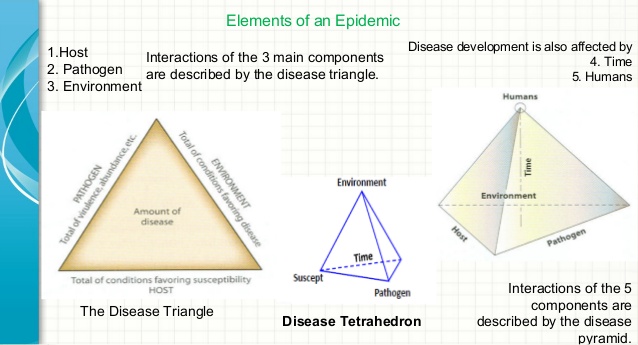
Elements of An Epidemic
Plant disease epidemics develop as a result of the timely combination of the same elements that result in plant disease: susceptible host plants, a virulent pathogen, and favorable environmental conditions over a relatively long period of time. Humans may unwittingly help initiate and develop epidemics through some of their activities, e.g., by topping or pruning plants in wet weather.
More frequently, humans may stop the initiation and development of epidemics by using appropriate control measures under situations in which epidemics would almost certainly occur without human intervention. Thus, the chance of an epidemic increases when the susceptibility of the host and virulence of the pathogen are greater, as the environmental conditions approach the optimum level for pathogen growth, reproduction, and spread, and as the duration of all favorable combinations is prolonged or repeated.
To describe the interaction of the components of plant disease epidemics, the disease triangle, which is discussed in Chapter 2 and describes the interaction of the components of plant disease, can be expanded to include time and humans. Indeed, the amount of each of the three components of plant disease and their interactions in the development of disease are affected by a fourth component: time. Both the specific point in time at which a particular event in disease development occurs and the length of time during which the event takes place affect the amount of disease. The interaction of the four components can be visualized as a tetrahedron, or pyramid, in which each plane represents one of the components. This figure is referred to as the disease tetrahedron or disease pyramid (Fig. 8-2). The effect of time on disease development becomes apparent when one considers the importance of the time of year (i.e., the climatic conditions and stage of growth when host and pathogen may coexist), the duration and frequency of favorable temperature and rains, the time of appearance of the vector, the duration of the infection cycle of
a particular disease, and so on. If the four components of the disease tetrahedron could be quantified, the volume of the tetrahedron would be proportional to the amount of disease on a plant or in a plant population.
Disease development in cultivated plants is also influenced greatly by a fifth component: humans. Humans affect the kind of plants grown in a given area, the degree of plant resistance, the numbers planted, time of planting, and density of the plants. By the resistance of the particular plants they cultivate, humans also determine which pathogens and pathogen races will
predominate. By their cultural practices, and by the chemical and biological controls they may use, humans affect the amount of primary and secondary inoculums available to attack plants. They also modify the effect of environment on disease development by delaying or speeding up planting or harvesting, by planting in raised beds or in more widely spaced beds, by protecting plant surfaces with chemicals before rains, by regulating the humidity in produce storage areas, and so on. The timing of human activities in growing and protecting plants may affect various combinations of these components to a considerable degree, thereby affecting the amount of disease in individual plants and in plant populations greatly. The human component has sometimes been used in place of the component “time” in the disease tetrahedron, but it should be considered a distinct fifth component that influences the development of plant disease directly and indirectly. In Fig. 8-3, host, pathogen, and environment are each represented by one of the sides of the triangle, time is represented as the perpendicular line arising from the center of the triangle and humans as the peak of the tetrahedron whose base is the triangle and height is the length of time. In this way, humans interact with and influence each of the other four components of an epidemic, thereby increasing or decreasing the magnitude of the epidemic. Sometimes, of course, humans themselves can be affected to a greater or lesser extent by plant disease epidemics.


